Ultrafast Fiber Bragg Grating Interrogation for Sensing in Detonation and Shock Wave Experiments
Abstract
:1. Introduction
2. CFBG Recording Systems and Sensors for Detonation and Shock Wave Research
2.1. GHz High Speed FBG Interrogation Systems
2.1.1. Spectrally-Integrated Approach
2.1.2. Time-Streaked Spectrally-Resolved Approach
2.2. Characteristics of Fiber Bragg Gratings for Detonation and Shock Physics Measurements
3. Experimental Tests
3.1. Linear Detonation Front Measurements in the Plastic Bonded Explosive PBX-9501
3.2. Tracking of a Radial Decaying Shock: Crossover to Non-Destructive CFBG response
3.3. Shock Wave Tracking along a Cylinder Wall under Weak Loading Accompanied by CFBG Strain Response Effects
4. Discussion
5. Conclusions
Acknowledgments
Author Contributions
Conflicts of Interest
Abbreviations
| FBG | Fiber Bragg grating |
| CFBG | Chirped fiber Bragg grating |
| PBX | Plastic bonded explosive |
| PDV | Photonic Doppler velocimetry |
| VISAR | Velocity interferometer for a system of any reflector |
| ASE | Amplified spontaneous emission |
| LUT | Look-up table |
| OBR | Optical backscatter reflectometer |
| LWG | Line wave generator |
| HE | High explosive |
| LoFi | Low fidelity |
| PMMA | Polymethylmethacrylate |
| ENOB | Effective number of bits |
References
- Rodriguez, G.; Sandberg, R.L.; McCulloch, Q.; Jackson, S.I.; Vincent, S.W.; Udd, E. Chirped fiber Bragg grating detonation velocity sensing. Rev. Sci. Instrum. 2013, 84, 015003. [Google Scholar] [CrossRef] [PubMed]
- Rodriguez, G.; Sandberg, R.L.; Jackson, S.I.; Vincent, S.W.; Gilbertson, S.M.; Udd, E. Fiber Bragg sensing of high explosive detonation experiments at Los Alamos National Laboratory. J. Phys. Conf. Ser. 2014, 500, 142030. [Google Scholar] [CrossRef]
- Barbarin, Y.; Lefrancois, A.; Zaniolo, G.; Chuzeville, V.; Jacquet, L.; Magne, S.; Luc, J.; Osmont, A. Optimization of detonation velocity measurements using a chirped fiber Bragg grating. Proc. SPIE 2015, 9480, 94800S. [Google Scholar]
- Gilbertson, S.; Jackson, S.I.; Vincent, S.W.; Rodriguez, G. Detection of high explosive detonation across material interfaces with chirped fiber Bragg gratings. Appl. Opt. 2015, 54, 3849–3854. [Google Scholar] [CrossRef]
- Rodriguez, G.; Jaime, M.; Balakirev, F.; Mielke, C.H.; Azad, A.; Marshall, B.; La Lone, B.M.; Henson, B.; Smilowitz, L. Coherent pulse interrogation system for fiber Bragg grating sensing of strain and pressure in dynamic extremes of materials. Opt. Express 2015, 23, 14219. [Google Scholar] [CrossRef] [PubMed]
- Rodriguez, G.; Jaime, M.; Mielke, C.H.; Balakirev, F.; Azad, A.; Sandberg, R.L.; Marshall, B.; La Lone, B.M.; Henson, B.F.; Smilowitz, L.; et al. Insight into fiber Bragg sensor response at 100-MHz interrogation rates under various dynamic loading conditions. Proc. SPIE 2015, 9480, 948004. [Google Scholar]
- Rodriguez, G.; Smilowitz, L.; Henson, B.F. Embedded fiber Bragg grating pressure measurement during thermal ignition of a high explosive. Appl. Phys. Lett. 2016, 109, 164101. [Google Scholar] [CrossRef]
- Ravid, A.; Shafir, E.; Zilberman, S.; Berkovic, G.; Glam, B.; Appelbaum, G.; Fedotov, G.A. Fibre Bragg grating sensor for shock wave diagnostics. J. Phys. Conf. Ser. 2014, 500, 142029. [Google Scholar] [CrossRef]
- Barbarin, Y.; Lefrancois, A.; Magne, S.; Woirin, K.; Sinatti, F.; Osmont, A.; Luc, J. Dynamic high pressure measurements using a fiber Bragg grating probe and an arrayed waveguide spectrometer. Proc. SPIE 2016, 9960, 99600U. [Google Scholar]
- Barbarin, Y.; Lefrancois, A.; Sinatti, F.; Bey, A.; Balbarie, M.; Osmont, A.; Luc, J. Dynamic dispersive spectrometer using a fiber Bragg grating for high pressure measurements. IEEE Sens. 2016. [Google Scholar] [CrossRef]
- Benterou, J.; Bennett, C.V.; Cole, G.; Hare, D.E.; May, C.; Udd, E.; Mihailov, S.J.; Lu, P. Embedded fiber optic Bragg grating (FBG) detonation velocity sensor. Proc. SPIE 2009, 7316, 73160E. [Google Scholar]
- Udd, E.; Benterou, J.; May, C.; Mihailov, S.J.; Lu, P. Review of high-speed fiber optic grating sensor systems. Proc. SPIE 2010, 7677, 76770B. [Google Scholar]
- Udd, E.; Benterou, J. Improvements to high-speed monitoring of events in extreme environments using fiber Bragg grating sensors. Proc. SPIE 2012, 8370, 83700L. [Google Scholar]
- La Lone, B.M.; Marshall, B.R.; Miller, E.K.; Stevens, G.D.; Turley, W.D.; Veeser, L.R. Simultaneous broadband laser ranging and photonic Doppler velocimetry for dynamic compression experiments. Rev. Sci. Instrum. 2015, 86, 023112. [Google Scholar] [CrossRef] [PubMed]
- Strand, O.T.; Goosman, D.R.; Martinez, C.; Whitworth, T.L.; Kuhlow, W.W. Compact system for high-speed velocimetry using heterodyne techniques. Rev. Sci. Instrum. 2015, 86, 023112. [Google Scholar] [CrossRef]
- Barker, L.M.; Shahinpoor, M.; Chhabildas, L.C. Experimental diagnostics and techniques. In High-Pressure Shock Compression of Solids; Asay, J.R., Shahinpoor, M., Eds.; Springer: New York, NY, USA, 1993; pp. 43–73. [Google Scholar]
- Udd, E.; Udd, I.; Benterou, J.; Rodriguez, G. Ultrafast fiber grating sensor systems for velocity, position, pressure, and temperature measurements. Proc. SPIE 2016, 9852. [Google Scholar] [CrossRef]
- Rodriguez, G.; Sandberg, R.L.; Jackson, S.I.; Dattelbaum, D.M.; Vincent, S.W.; McCulloch, Q.; Martinez, R.M.; Gilbertson, S.M.; Udd, E. Fiber Bragg grating sensing of detonation and shock experiments at Los Alamos National Laboratory. Proc. SPIE 2013, 8722, 872204. [Google Scholar]
- Rodriguez, G.; Sandberg, R.L.; La Lone, B.M.; Marshall, B.R.; Grover, M.; Stevens, G.; Udd, E. High pressure sensing and dynamics using high speed fiber Bragg grating interrogation systems. Proc. SPIE 2014, 9098, 90980C. [Google Scholar]
- Jackson, S.I.; Short, M. Scaling of detonation velocity in cylinder and slab geometries for ideal, insensitive and non-ideal explosives. J. Fluid Mech. 2015, 773, 224–266. [Google Scholar] [CrossRef]
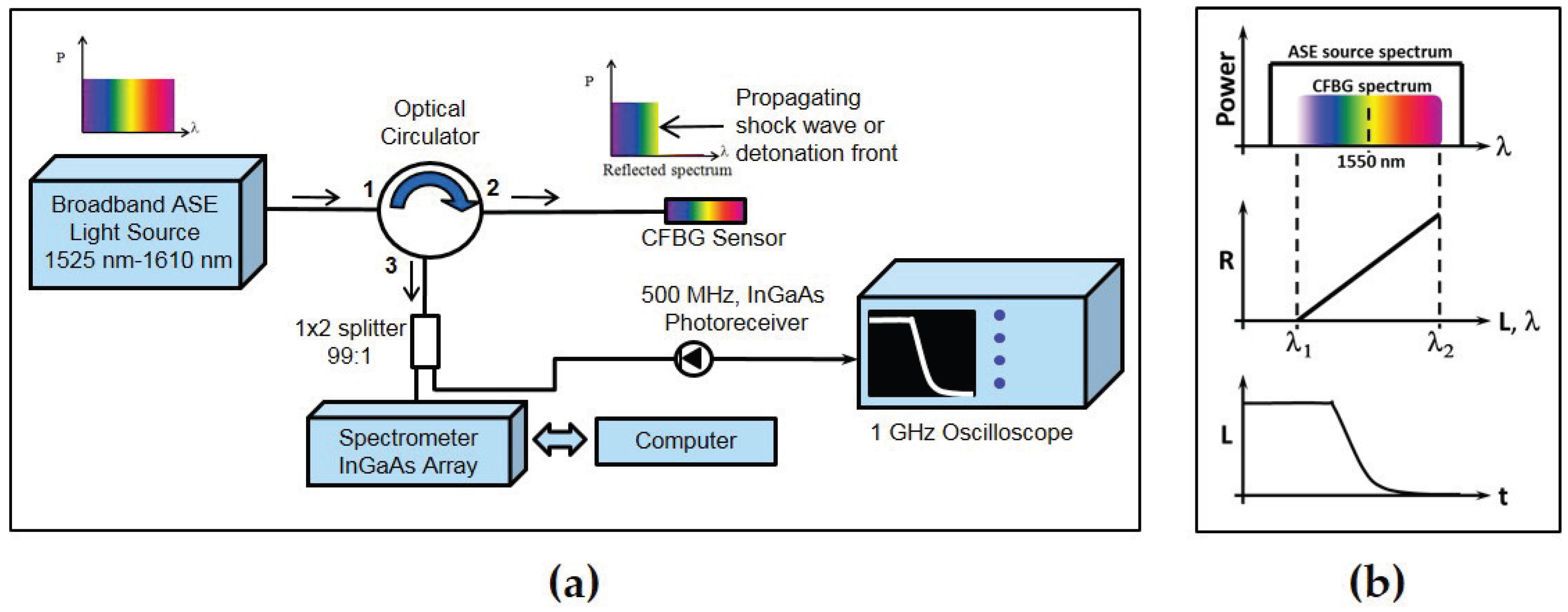
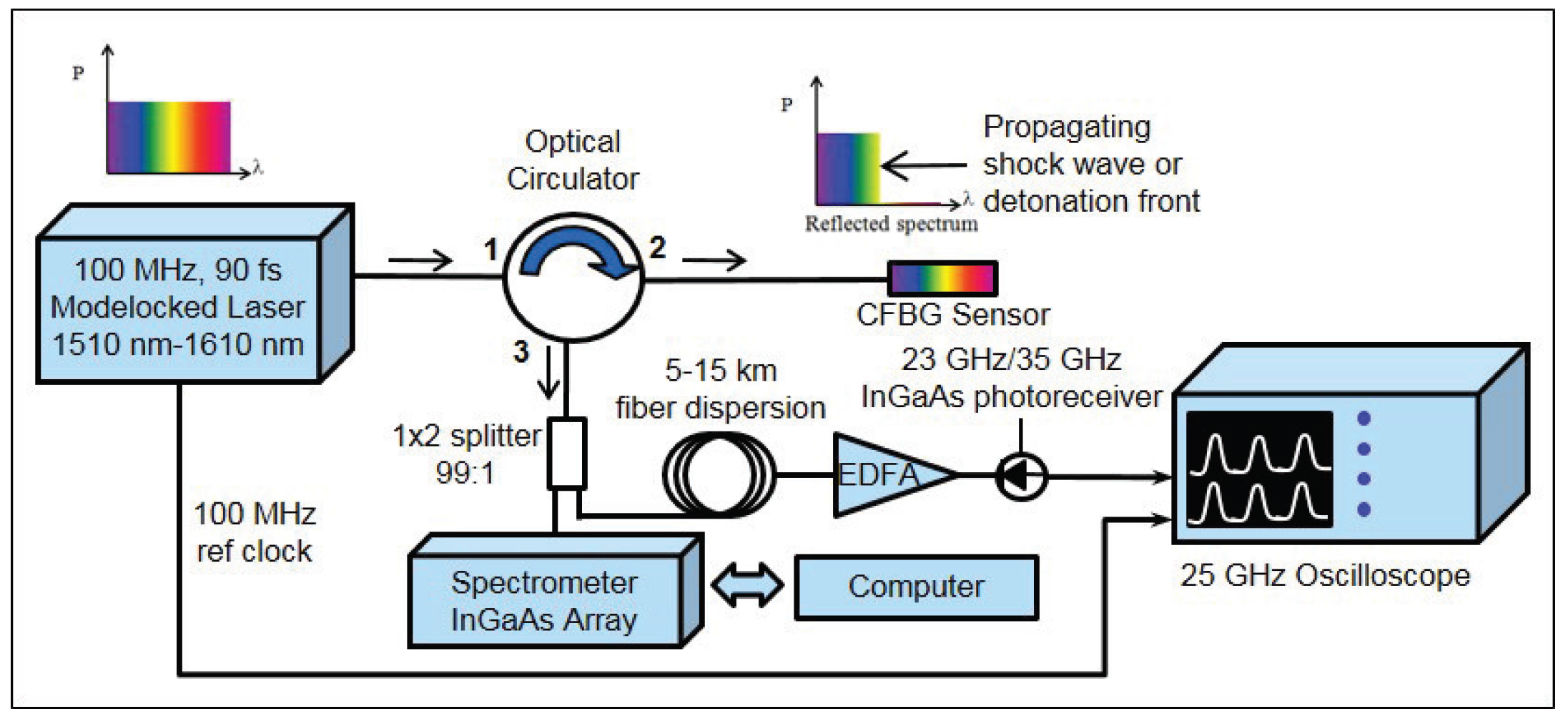


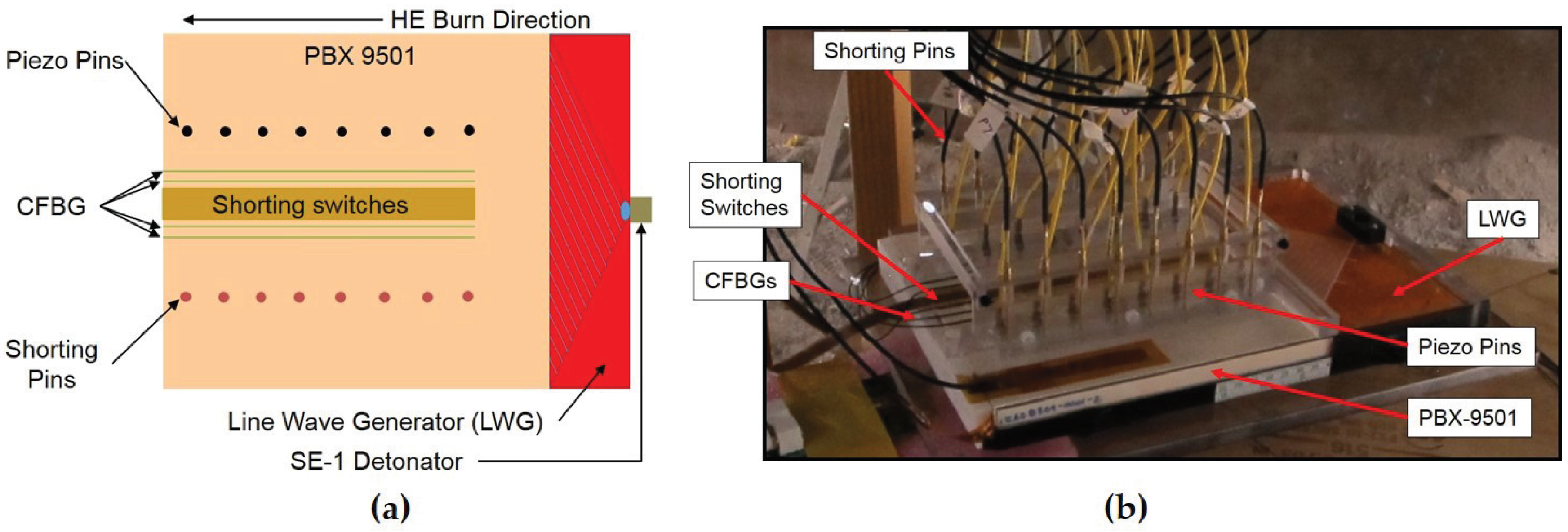
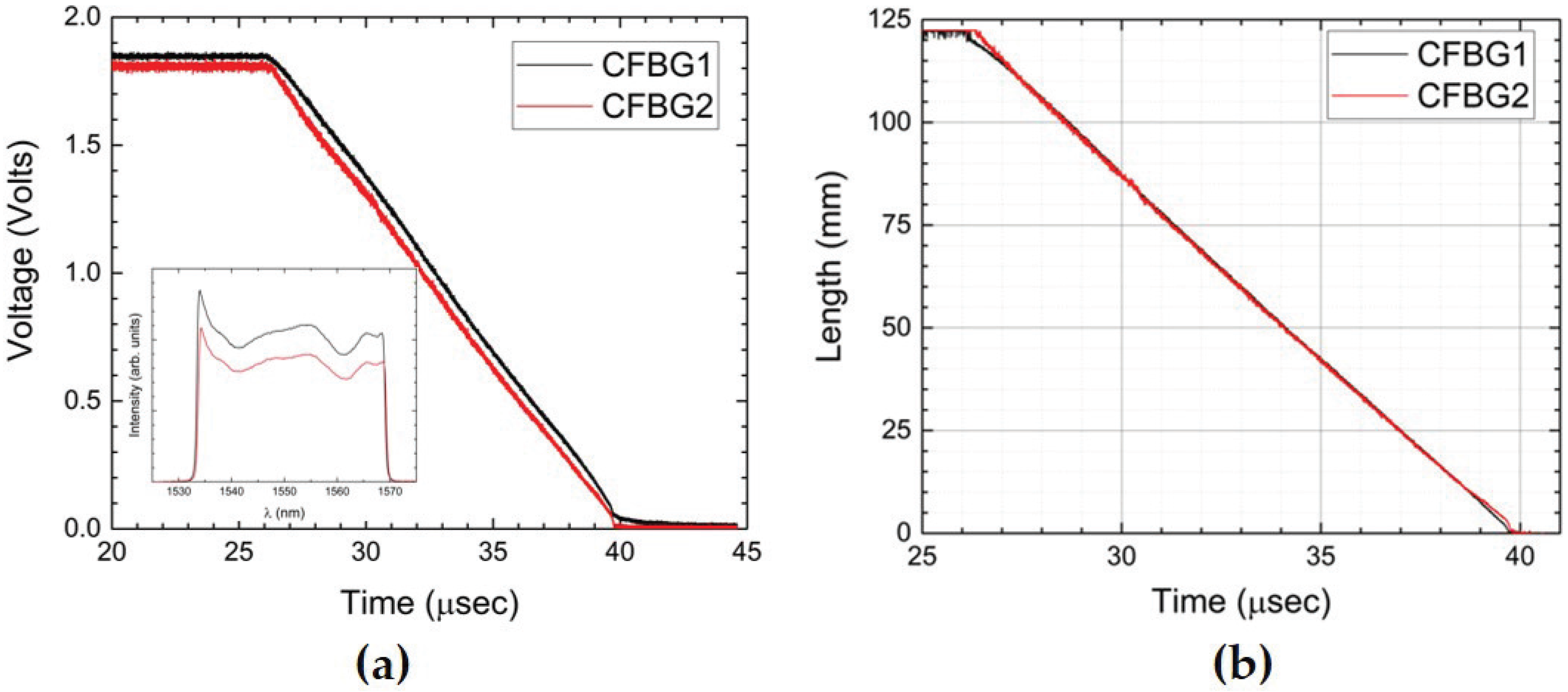

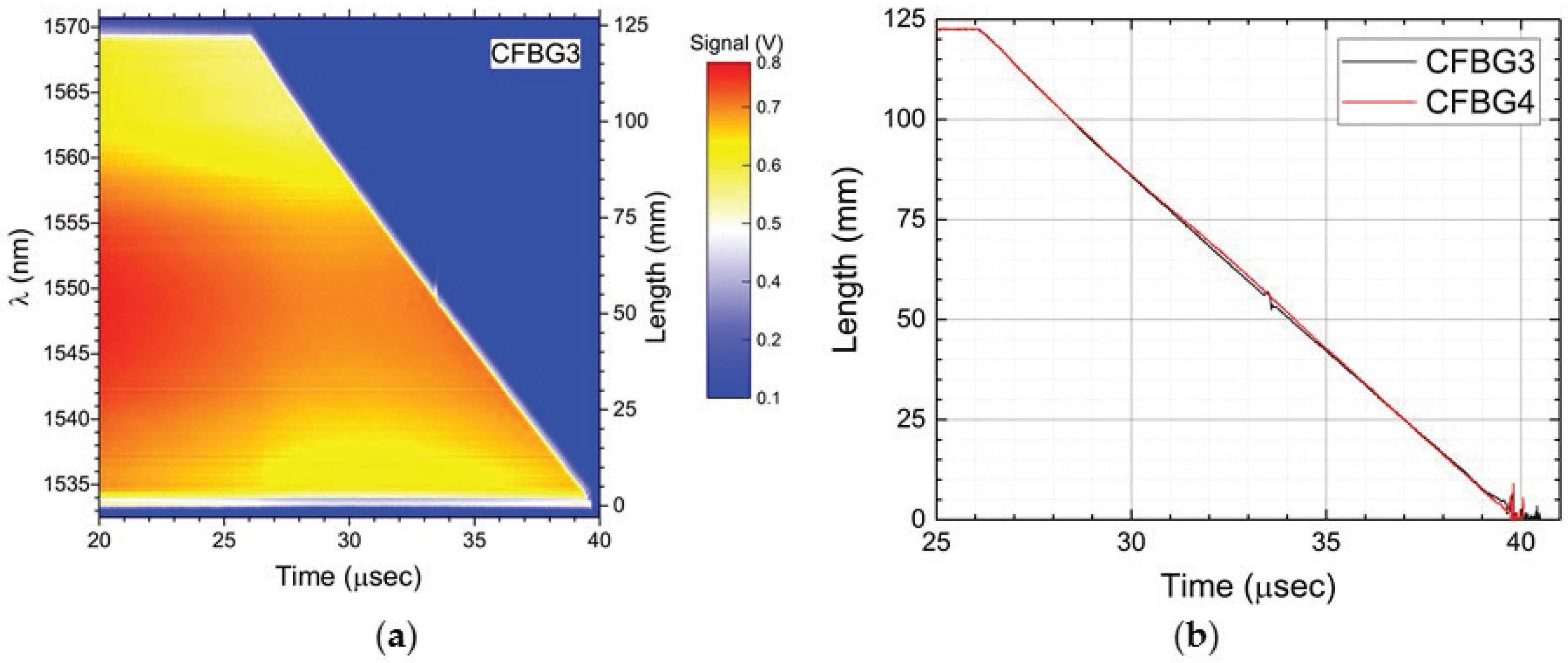
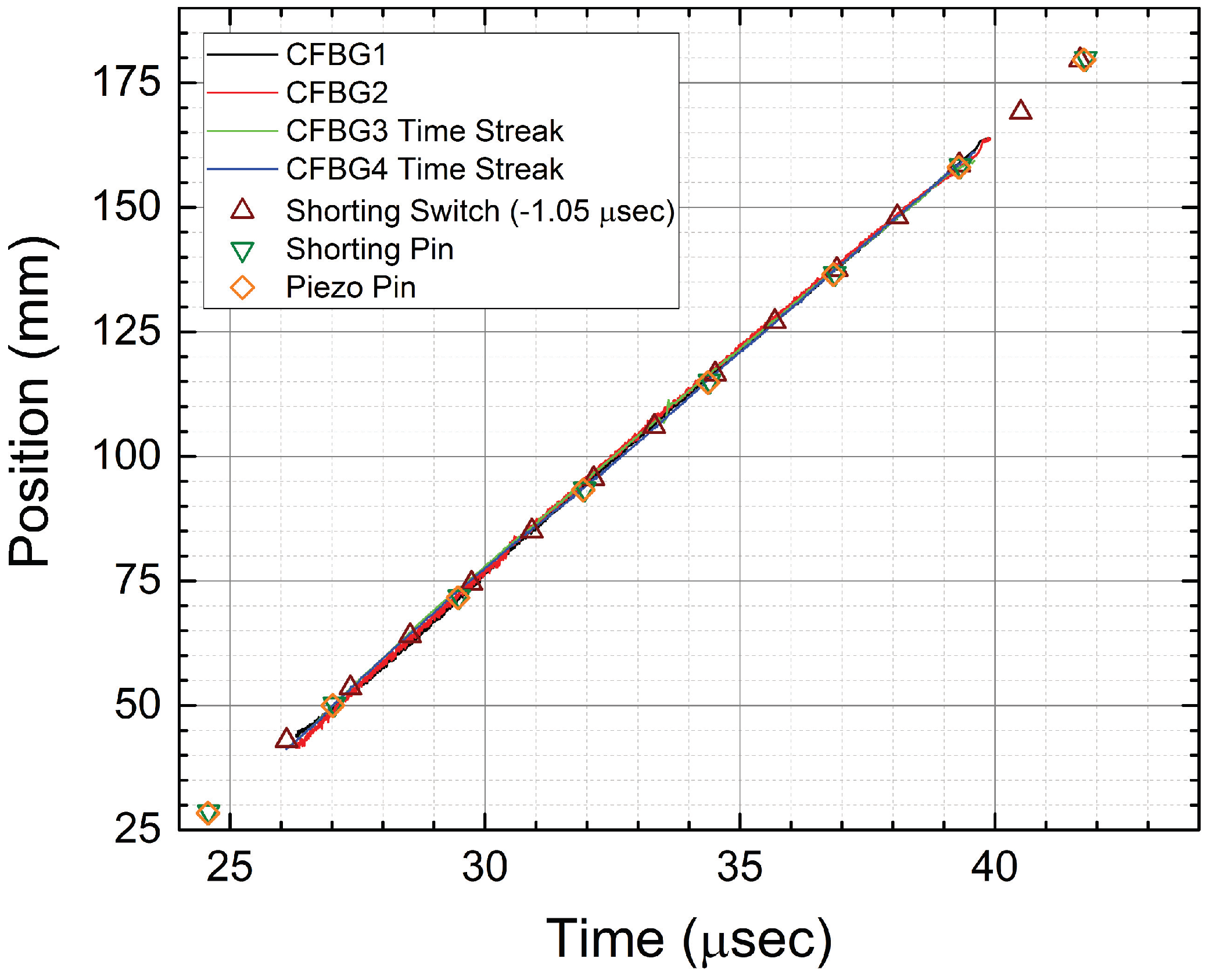

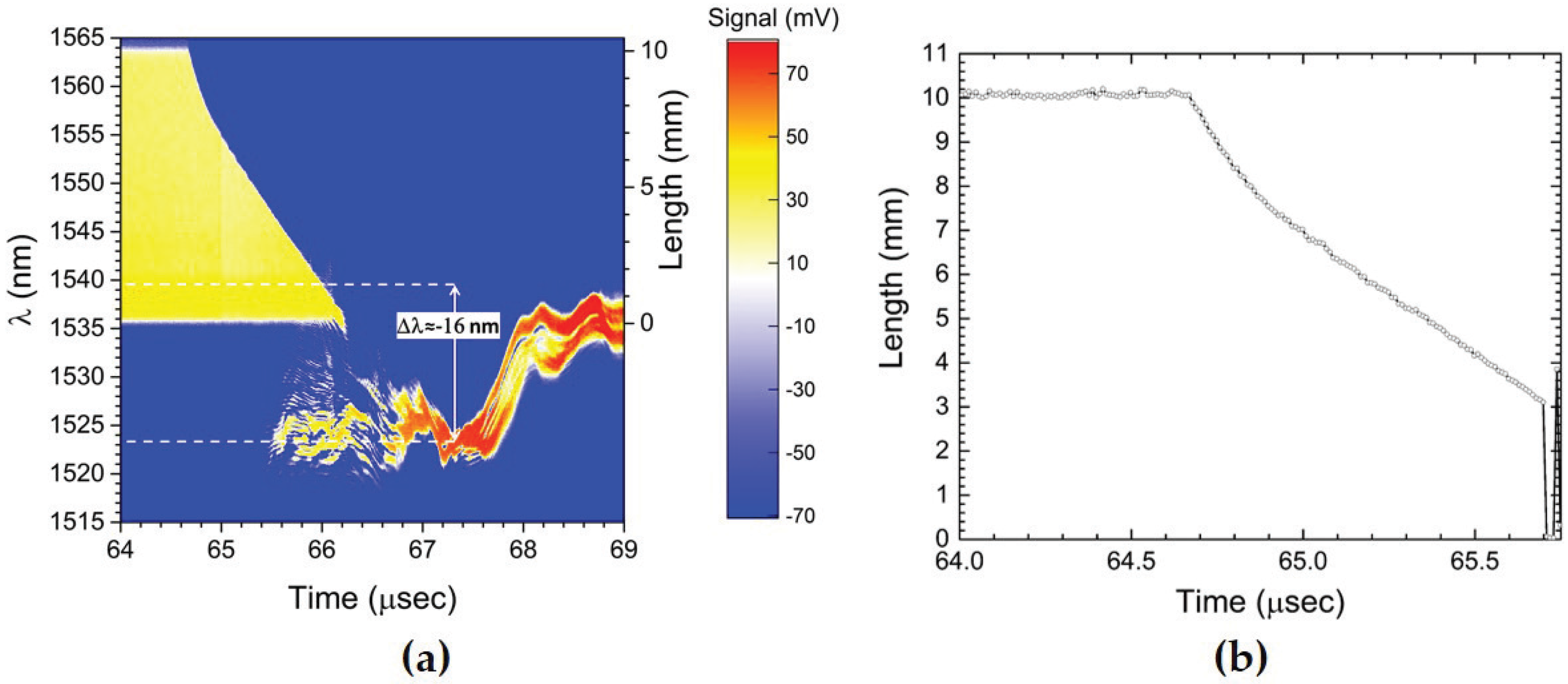
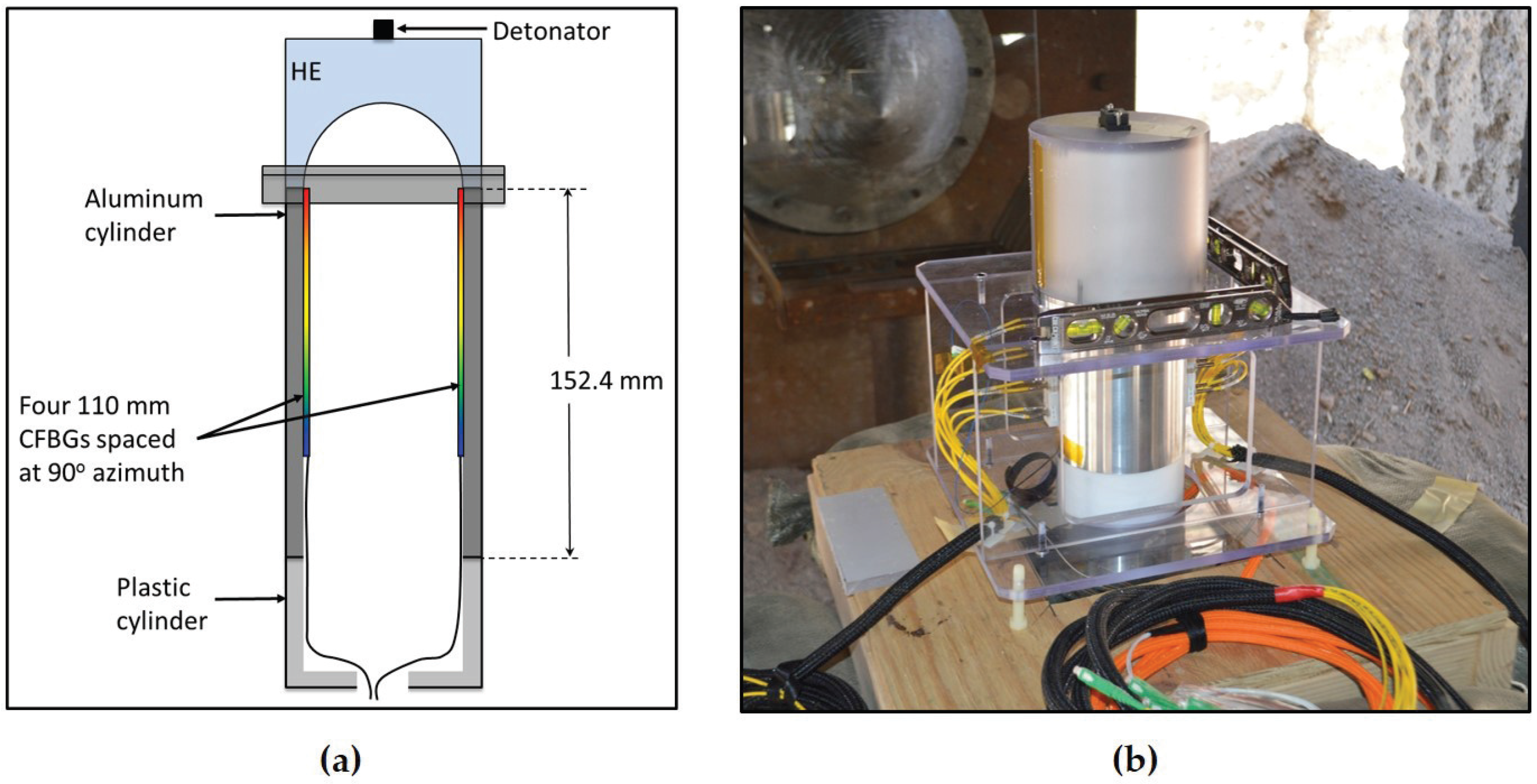


| Length (mm) | Band | Chirp (mm/nm) | Coating |
|---|---|---|---|
| 10 | C | 0.35 | acrylate |
| 100 | C, C + L | 3.5, 1.75 | polyimide, acrylate |
| 120 | C | 3.4 | polyimide, acrylate |
| 200 | C, C + L | 3.45 | polyimide |
| Diagnostic | Sensor Count | CFBG Chirp (mm/nm) or Pin Spacing (mm) |
|---|---|---|
| CFBG | 2 (120 mm) | 3.41, 3.42 |
| Time-Streak CFBG | 2 (120 mm) | 3.43, 3.42 |
| Shorting Switch | 16 | 10.5 |
| Shorting Pin | 8 | 25.4 |
| Piezo Pin | 8 | 25.4 |
| Diagnostic | Measured Velocity (mm/s) |
|---|---|
| CFBG | 8.84 ± 0.014 |
| Shorting Switch | 8.78 ± 0.11 |
| Shorting Pin | 8.80 ± 0.04 |
| Piezo Pin | 8.80 ± 0.03 |
© 2017 by the authors. Licensee MDPI, Basel, Switzerland. This article is an open access article distributed under the terms and conditions of the Creative Commons Attribution (CC BY) license ( http://creativecommons.org/licenses/by/4.0/).
Share and Cite
Rodriguez, G.; Gilbertson, S.M. Ultrafast Fiber Bragg Grating Interrogation for Sensing in Detonation and Shock Wave Experiments. Sensors 2017, 17, 248. https://doi.org/10.3390/s17020248
Rodriguez G, Gilbertson SM. Ultrafast Fiber Bragg Grating Interrogation for Sensing in Detonation and Shock Wave Experiments. Sensors. 2017; 17(2):248. https://doi.org/10.3390/s17020248
Chicago/Turabian StyleRodriguez, George, and Steve M. Gilbertson. 2017. "Ultrafast Fiber Bragg Grating Interrogation for Sensing in Detonation and Shock Wave Experiments" Sensors 17, no. 2: 248. https://doi.org/10.3390/s17020248





